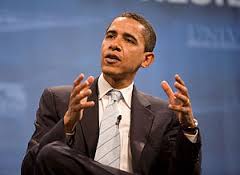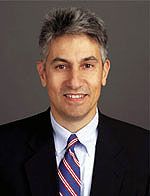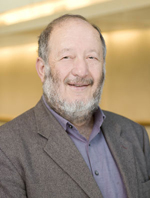January 13, 2009 - By Krista Conger

Credit: Ralph Alswang
Scientists and policymakers have high hopes that President-elect Barack Obama will move swiftly to lift the funding restrictions on embryonic stem cell research.
Within days of the Jan. 20 inauguration, President Barack Obama could set a new stage for stem cell research: he is widely expected to issue an executive order reversing President George W. Bush's restrictions on federal funds for human embryonic stem cell research.
Such a step would not only channel more money to stem cell work, but also lead to increased availability of human embryonic stem cell lines for study - and eliminate a complex bureaucracy that has arisen to enforce the Bush provision. What's more, it could cement California's standing as an epicenter for stem cell research, which was made possible by the $3 billion in state funds allocated to this burgeoning field by Proposition 71. Perhaps most important, it would signal the new administration's commitment to advancing medical research.
'Science is a gift from God to all of us,' U.S. House Speaker Nancy Pelosi, D-Calif., said in an interview for this story. 'Scientists have been given an almost biblical power to cure through advances in embryonic stem cell research. A repeal of the ban is critical so that we may take advantage of the opportunity to save lives, find cures and give hope to those suffering. It is an opportunity that we cannot miss.'
President Bush, early in his first term, prohibited federal funding of research conducted on any human embryonic stem cell lines created after Aug. 9, 2001. Although representatives of Obama's transition team declined to comment on his plans, Pelosi and other policymakers expect him to quickly issue an executive order repealing the ban. Congress would also be working to pass legislation that would enhance support for stem cell research and ensure that future presidents couldn't unilaterally change the policy without congressional approval. 'It is one of our top priorities,' Pelosi said. Legislation removing the ban has been passed twice during the last few years, and Bush vetoed it both times.
Researchers cautioned that in the current economic climate, no one should be expecting a windfall of new grants. Yet even a modest increase would help scientists - in both spirit and substance. 'Lifting the ban on the use of federal funding for human embryonic stem cell research will end a sorry chapter in federal research policies and usher in a new era in this promising field of medicine,' said Philip Pizzo, MD, dean of the School of Medicine and a member of the board overseeing California's stem cell agency. 'It would provide scientists with much-needed resources to speed discoveries and devise new treatments for some of the most vexing diseases and severe injuries.'

Philip Pizzo
Bush's prohibition has meant that researchers who wished to proceed with new human embryonic stem cell lines needed to have separate funding not just for the reagents in their experiments, but also for the equipment and laboratory space used to conduct the research. At the urging of the National Research Council and the Institute of Medicine, many institutions, including Stanford, organized Stem Cell Research Oversight, or SCRO, committees to grapple with the legal, ethical and scientific issues of human embryonic stem cell research.
'It's very expensive to adopt this kind of a Noah's ark mentality,' said Michael Longaker, MD, deputy director of Stanford's Stem Cell Biology and Regenerative Medicine Institute. 'When we first formed our SCRO, we went through laboratories trying to decide whether individual pieces of equipment and laboratory glassware should have a green sticker (OK to use) or a red sticker (don't use). Could you talk about your stem cell research on a common phone in the laboratory, or use a shared computer to e-mail research results? We just didn't know.' A lifting of the ban would make research on previously unapproved human embryonic stem cell lines much less logistically challenging.
It could also increase the availability of these stem cells for research. When Bush barred the use of federal funds to finance the creation of or research on any new cell lines - he considers it immoral to destroy embryos for research purposes - he claimed that more than 60 previously established human embryonic stem cell lines already existed for research purposes. Unfortunately, nearly all of these lines were grown in an environment that likely makes them unsafe for use in humans. Because of other complications, only 21 eligible cell lines remain available today for research worldwide, according to the National Institutes of Health. It can be extremely difficult to grow some of these lines in laboratories, and scientists complain about the lack of genetic diversity in this limited pool.

Michael Longaker
Even with an executive order from Obama and legislation from Congress ending the ban on research funding (such as the Stem Cell Research Enhancement Act), the government would still be prohibited from funding the creation of new lines. The Dickey-Wicker amendment, first passed in 1995, prohibits the use of federal funds for the creation of human embryos for research purposes or the destruction or injury of human embryos. Although a repeal of the amendment is not absolutely necessary - as it neither prohibits the derivation of new lines with private money nor bars federal funding for research on these lines - many researchers feel the government shouldn't impose moral or ethical restrictions on the advancement of science.
'I believe that, in the big picture, the introduction of political, religious and moral ideologies to restrict medical and scientific research is the most dangerous part of Bush's policy,' said Irving Weissman, MD, the Virginia & D.K. Ludwig Professor for Clinical Investigation in Cancer Research and director of Stanford's Institute for Stem Cell Biology and Regenerative Medicine. 'The most important action the Obama administration can take is to erase ideology from the oversight and funding of all aspects of stem cell research and medicine.'
Pelosi added: 'Personally, I believe it would be wise to repeal the Dickey-Wicker amendment in order to remove the barriers for America's scientists to pursue the science they believe has the most promise to cure. However, the passage of the Stem Cell Research Enhancement Act to allow for increased federal funding of stem cell research is a higher priority, and repeal of Dickey-Wicker will be considerably more difficult.'

Nancy Pelosi
Scientists in California have a particular interest in what Obama and Congress decide to do. Already, the California Institute of Regenerative Medicine, which was established as a result of Prop. 71 in 2004, has given out more than $600 million in state grants, with Stanford receiving more than any other institution - about $95 million. 'Any federal funds would not be a replacement for CIRM support, but in addition to its resources,' Longaker added. 'Being able to apply for a mixture of federal and state funding for research projects would be a huge positive.'
Prop. 71 requires CIRM to allocate a total of $3 billion over a 10-year period. Because of the initiative, California has laid a foundation for stem cell research that surpasses what is in place elsewhere in the nation. The money has led a number of the nation's leading stem cell researchers to move to California, including two who came to Stanford - Michael Clarke, MD, from the University of Michigan, and Philip Beachy, PhD, from Johns Hopkins. And the CIRM money has attracted private matching funds that have enabled the building of new stem cell centers, such as the Lorry I. Lokey Stem Cell Research Building at Stanford, projected to be the largest stem cell research facility in the nation.
'Essentially, California has had the advantage of SEED grants, research grants and facilities grants from the institute that have been unavailable to the rest of the country,' said Robert Klein, chair of CIRM's governing body. 'We've built up the intellectual infrastructure to have a significant advantage when competing for newly available NIH funds.'
Klein and others said it's possible that existing NIH funds may be reallocated to more strongly favor human embryonic stem cell research over other types of endeavors. Yet federal money is unlikely to supplant what CIRM is doing.
'On a real dollar level,' said Klein, 'any additional funding will not even come close to what is needed. It's not even in the same ballpark. Furthermore, the type of funding is important. The NIH does not typically fund the early-phase human trials that are so important to driving therapy forward.'
CIRM's new loan program for biotechnology companies, for instance, is meant to provide a revolving source of support for institutions testing the safety and efficacy of possible human embryonic stem-cell-based therapies. Those sorts of ventures may not qualify for federal funding even if the ban is lifted.
The Obama administration would need to establish its own guidelines for stem cell research, Rick Weiss, a senior fellow at the Center for American Progress, recently wrote. It would need to spell out how stem cell lines were derived and embryos acquired in order to be eligible for federal research support. The Bush administration's policy, he wrote, had the unintended consequence of providing no federal rules for much of the embryonic stem cell research conducted since 2001.

Irving Weissman
'The current Bush policy harms U.S. interests not just because it severely restricts the use of federal funds for a potentially life-saving new branch of medical science,' Weiss wrote. 'It also hurts the nation because, to the extent it allows such research to go forward, it demands almost nothing in the way of ethical constraints.' In other words, Bush's attempt to claim the moral high ground on a contentious issue stranded the very research he was trying to regulate in murky ethical waters.
The new president could change that, but Congress has a role to play as well. 'By passing bipartisan federal legislation,' Pelosi noted, 'we would bring embryonic stem cell research under the strict controls and ethical guidelines of the National Institutes of Health.'
Weissman encourages the NIH to adopt the principles and practices approved by the National Academies and CIRM to guide such research. Regardless, he said, 'it is important that any new NIH guidelines do not replace one set of ideologies with another. Banning certain types of research for religious or ideological reasons is not the American way.'
About Stanford Medicine
Stanford Medicine is an integrated academic health system comprising the Stanford School of Medicine and adult and pediatric health care delivery systems. Together, they harness the full potential of biomedicine through collaborative research, education and clinical care for patients. For more information, please visit med.stanford.edu.